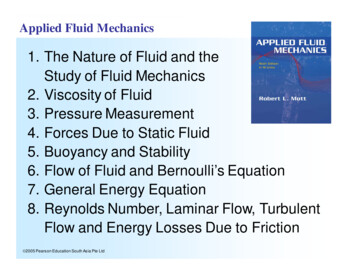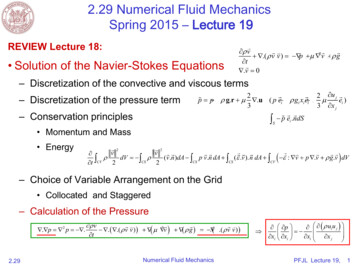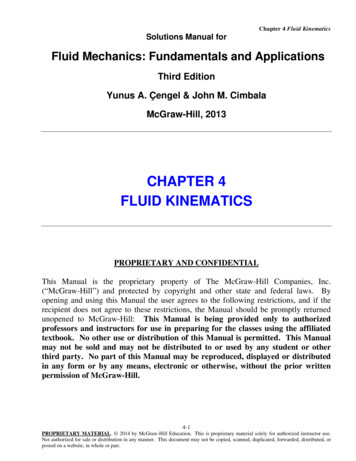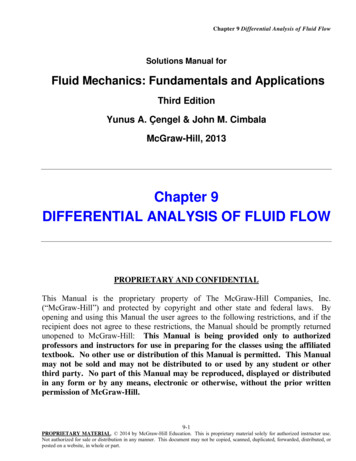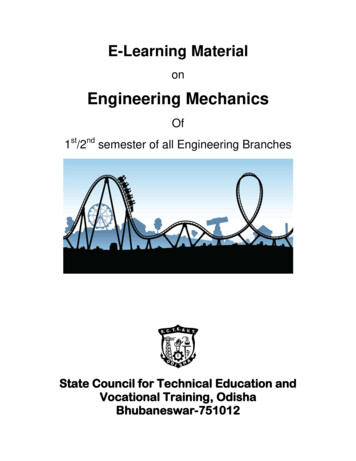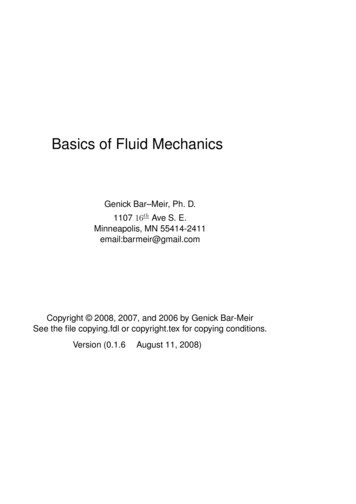
Transcription
Objectives dimensional homogeneity nondimensionalize the equations dimensional analysis, in which the combination of dimensionalvariables, nondimensional variables, and dimensional constantsinto nondimensional parameters reduces the number of necessaryindependent parameters in a problem. ) به منظور . ثوابت و ، بی بعد ، ترکیب متغیرها و پارامترهای مسأله (بعد دار : آنالیز ابعادی کاهش تعداد متغیرهای درگیر (مستقل) در مسأله
Nondimensionalization of Equations divide each term in the equation by a collection of variables andconstants whose product has those same dimensions, the equationis rendered nondimensional.
Nondimensionalization of Equations As a simple example:𝑬𝒒𝒖𝒂𝒕𝒊𝒐𝒏 𝒐𝒇 𝒎𝒐𝒕𝒊𝒐𝒏:𝒅𝟐 𝒛 𝒈𝒅𝒕𝟐𝒘: 𝒗𝒆𝒍𝒐𝒄𝒊𝒕𝒚 𝒊𝒏 𝒛 𝒅𝒊𝒓𝒆𝒄𝒕𝒊𝒐𝒏𝑎𝑡 𝑡 0: 𝑧 𝑧0 & 𝑤 𝑤0𝑫𝒊𝒎𝒆𝒏𝒔𝒊𝒐𝒏𝒂𝒍 𝒓𝒆𝒔𝒖𝒍𝒕: 𝒛 𝒛𝟎 𝒘𝟎 𝒕 𝟏𝒈𝒕𝟐𝟐
Nondimensionalization of Equations To nondimensionalize equation of motion, we need to selectscaling parameters, based on the primary dimensions contained inthe original equation. In a typical fluid flow problem, the scaling parameters usuallyinclude: Other parameters and fluid properties such as density, viscosity,and gravitational acceleration enter the problem as well.
Nondimensionalization of ���𝒏𝒂𝒍𝒊𝒛𝒆𝒅 ���𝒕𝒊𝒐𝒏 𝒐𝒇 𝒎𝒐𝒕𝒊𝒐𝒏:𝒛 𝒛 ,𝒛𝟎𝒕 𝒘𝟎 𝒕 𝒛𝟎𝒅𝟐 𝒛 𝒈𝒅𝒕𝟐𝒅𝟐 𝒛𝒅 𝒅𝒛𝒅 𝒅 𝒛𝟎 𝒛 𝒅 𝒘𝟎 𝒅𝒛 𝒅 𝒘𝟎𝒕 𝒛𝟎𝒅𝒕𝟐 𝒅𝒕 𝒅𝒕𝒅𝒕 𝒅 𝒕 𝒛𝟎𝒅𝒕 𝒅𝒕 𝒅𝒘𝟎𝒘𝟎𝒘𝟐𝟎 𝒅 𝒅𝒛 𝒘𝟐𝟎 𝒅𝟐 𝒛 𝒛𝟎 𝒅𝒕 𝒅𝒕 𝒛𝟎 𝒅𝒕 𝟐𝒅𝟐 𝒛 𝒘𝟐𝟎 𝒅𝟐 𝒛 𝒘𝟐𝟎 𝒅𝟐 𝒛 𝒈 𝟏𝒅𝒕𝟐𝒛𝟎 𝒅𝒕 𝟐𝒈𝒛𝟎 𝒅𝒕 𝟐𝒅𝒛 𝒅𝒕
Nondimensionalization of Equations𝑭𝒓𝒐𝒖𝒅 𝒏𝒖𝒎𝒆𝒃𝒓:𝒘𝟎𝑭𝒓 ��𝒐𝒏𝒂𝒍𝒊𝒛𝒆𝒅 𝒆𝒒𝒖𝒂𝒕𝒊𝒐𝒏 𝒐𝒇 𝒎𝒐𝒕𝒊𝒐𝒏:𝒅𝟐 𝒛 𝒅𝒕 𝟐 𝟏𝑭𝒓𝟐𝑎𝑡 𝑡 0: 𝑧 𝑧0 𝑧 1𝒅𝒛 𝒅 𝒛𝟎 𝒛 𝒘𝟎 𝒅𝒛 𝒅𝒛 & 𝑤 𝑤0 𝒘 𝒘𝟎 𝒂𝒕 𝒕 𝟎: 𝟏𝒅𝒕 𝒅 𝒕 𝒛𝟎𝒅𝒕 ��𝒔𝒊𝒐𝒏𝒂𝒍 𝒓𝒆𝒔𝒖𝒍𝒕:𝒛 𝟏 𝒕 𝟏 𝟐 𝒕𝟐 𝑭𝒓𝟐
Advantages of NondimensionalizationAdvantages ofNondimensionalizationof an Equation
Advantages of NondimensionalizationTrajectories of a steel ball falling in a vacuum: a) z0 variations, w0fixed; b) w0 variations, z0 fixed
Advantages of NondimensionalizationTrajectories of a steel ball falling in a vacuum. Data a & b arenondimensionalized and combined onto one plot.
Nondimensionalization of EquationsMass conservation equation:Navier-Stokes equations:
Nondimensionalization of EquationsTo nondimensionalize these equations,divide all lengths by a reference length, L,and all velocities by a reference speed, 𝑽 , which usually is takenas the freestream velocity.and the pressure by 𝝆𝑽𝟐 (twice the freestream dynamic pressure).
Nondimensionalization of EquationsMass conservation equation:Navier-Stokes equations (x-dir):
Nondimensionalization of EquationsReynolds number
Nondimensionalization of Equations
Dimensional Analysis & Similarity There are 3 necessary conditions for complete similarity betweena model and a prototype.
Dimensional Analysis & Similarity In a general flow field, complete similarity between a model andprototype is achieved only when there is geometric, kinematic,and dynamic similarity.𝚷: 𝒅𝒆𝒏𝒐𝒕𝒆 𝒂 ��𝒍 𝒑𝒂𝒓𝒂𝒎𝒆𝒕𝒆𝒓 You are already familiar with one 𝚷 “Froude number, Fr”.
Dimensional Analysis & Similarity In a general dimensional analysis problem,1 dependent 𝜫: 𝜫𝟏Other 𝜫′ 𝒔: 𝜫𝟐 , 𝒆𝒕𝒄. : 𝒊𝒏𝒅𝒆𝒑𝒆𝒏𝒅𝒆𝒏𝒕 ��𝒕𝒊𝒐𝒏𝒂𝒍 𝒓𝒆𝒍𝒂𝒕𝒊𝒐𝒏𝒔𝒉𝒊𝒑 𝒃𝒆𝒕𝒘𝒆𝒆𝒏 𝜫′ 𝒔:𝜫𝟏 𝒇(𝜫𝟐 , 𝜫𝟑 , , 𝜫𝒌 ) Where k is the total number of 𝚷′ 𝒔. To ensure complete similarity, the model and prototype must begeometrically similar, and all independent pi groups must matchbetween model and prototype.𝜫𝟐,𝒎 𝜫𝟐,𝒑 ; 𝜫𝟑,𝒎 𝜫𝟑,𝒑 ; ; 𝜫𝒌,𝒎 𝜫𝒌,𝒑
Dimensional Analysis & Similarity Under these conditions the dependent pi of the model isguaranteed to also equal the dependent pi of the prototype.𝒊𝒇𝜫𝟐,𝒎 𝜫𝟐,𝒑 ; 𝜫𝟑,𝒎 𝜫𝟑,𝒑 ; ; 𝜫𝒌,𝒎 𝜫𝒌,𝒑𝒕𝒉𝒆𝒏 𝜫𝟏,𝒎 𝜫𝟏,𝒑
Dimensional Analysis & Similarity
Dimensional Analysis & Similarity The Reynolds number is the most well known and usefuldimensionless parameter in all of fluid mechanics.magnitude of the aerodynamic drag on the carReynolds number In this problem there is only one independent pi; & it was said ifthe independent pi match (the Reynolds numbers match); then theindependent pi also match.𝒊𝒇𝜫𝟐,𝒎 𝜫𝟐,𝒑 (𝑹𝒆𝒑 𝑹𝒆𝒎 )𝒕𝒉𝒆𝒏 𝜫𝟏,𝒎 𝜫𝟏,𝒑
Dimensional Analysis & Similarity This enables engineers to measure the aerodynamic drag on themodel car and then use this value to predict the aerodynamic dragon the prototype car.
Dimensional Analysis & Similarity
Dimensional Analysis & Similarity
Dimensional Analysis & Similarity
Dimensional Analysis & Similarity
Dimensional Analysis & Similarity The power of using dimensional analysis and similarity tosupplement experimental analysis is: actual values of thedimensional parameters (density, velocity, etc.) are irrelevant. Aslong as the corresponding independent Pi’s are set equal to eachother, similarity is achieved, even if different fluids are used.
Buckingham Pi Theorem نظریه پای باکینگهام : یک پدیده فیزیکی را در نظر بگیرید که در آن پارامتر وابسته تابعی از n-1 پارامتر مستقل باشد . 𝒏𝒒 𝒐𝒓 𝒈 𝒒𝟏 , 𝒒𝟐 , 𝒒𝟑 , , 𝒏𝒒 𝒒𝟏 𝒇 𝒒𝟐 , 𝒒𝟑 , , برای رابطه g می توان n پارامتر داده شده را بصورت n-m نسبت بی بعد مستقل گروه بندی کرد . این نسبت ها را پارامترهای پای می گویند و بصورت زیر نوشته می شوند . 𝟎 𝒎 𝑮 𝚷𝟏 , 𝚷𝟐 , , 𝚷𝒏 or 𝟎 𝒎 𝚷𝟏 𝑮𝟏 𝚷𝟐 , 𝚷𝟑 , , 𝚷𝒏
Buckingham Pi TheoremPi’s Variables? Now: how to generate the nondimensional parameters, i.e., thepi’s several methods; the most popular (and simplest) method is themethod of repeating variables, popularized by Edgar Buckingham(1867–1940)6 steps As a simple first example, consider a ball falling in a vacuum asdiscussed before.
Buckingham Pi TheoremStep 1 List the parameters (dimensional variables, nondimensionalvariables, and dimensional constants) and count them. Let n be the total number of parameters in the problem, includingthe dependent variable.𝑬𝒙𝒂𝒎𝒑𝒍𝒆: 𝑳𝒊𝒔𝒕 𝒐𝒇 𝒓𝒆𝒍𝒆𝒗𝒂𝒏𝒕 𝒑𝒂𝒓𝒂𝒎𝒆𝒕𝒆𝒓𝒔:𝒛 𝒇 𝒕, 𝒘𝟎 , 𝒛𝟎 , 𝒈𝑬𝒒𝒖𝒂𝒕𝒊𝒐𝒏 𝒐𝒇 𝒎𝒐𝒕𝒊𝒐𝒏:𝒏 𝟓𝒅𝟐 𝒛 ��𝒏𝒂𝒍 𝒓𝒆𝒔𝒖𝒍𝒕: 𝒛 𝒛𝟎 𝒘𝟎 𝒕 𝒈𝒕𝟐𝟐
Buckingham Pi TheoremStep 2 List the primary dimensions for each of the n ��𝟎𝒛𝟎𝒈𝑳𝟏𝒕𝟏𝑳𝟏 𝒕 𝟏𝑳𝟏𝑳𝟏 𝒕 𝟐𝑬𝒒𝒖𝒂𝒕𝒊𝒐𝒏 𝒐𝒇 𝒎𝒐𝒕𝒊𝒐𝒏:𝒅𝟐 𝒛 ��𝒏𝒂𝒍 𝒓𝒆𝒔𝒖𝒍𝒕: 𝒛 𝒛𝟎 𝒘𝟎 𝒕 𝒈𝒕𝟐𝟐
Buckingham Pi TheoremStep 3 Guess the reduction j. As a first guess, set j equal to the number of primary dimensionsrepresented in the problem. The expected number of Pi’s (k) is equal to n minus j, according tothe Buckingham Pi theorem. Example: As a first guess, j is set equal to 2, the number ofprimary dimensions represented in the problem (L and t).– Reduction:𝒋 𝟐 If this value of j is correct, the number of Pi’s predicted by theBuckingham Pi theorem is:𝑵𝒖𝒎𝒃𝒆𝒓 𝒐𝒇 𝒆𝒙𝒑𝒆𝒄𝒕𝒆𝒅 𝜫’𝒔: 𝒌 𝒏 𝒋 𝟓 𝟐 𝟑
Buckingham Pi TheoremStep 4 Choose j repeating parameters that will be used to construct eachPi. Example: We need to choose two repeating parameters since j 2.𝑹𝒆𝒑𝒆𝒂𝒕𝒊𝒏𝒈 𝒑𝒂𝒓𝒂𝒎𝒆𝒕𝒆𝒓𝒔: 𝒘𝟎 & 𝒛𝟎
Buckingham Pi TheoremStep 5 Generate the Pi’s one at a time by grouping the j repeatingparameters with one of the remaining parameters, forcing theproduct to be dimensionless.
Buckingham Pi Theorem𝒂𝒃𝜫𝟏 𝒛𝒘𝟎𝟏 �� 𝒐𝒇 𝜫𝟏 :𝑳𝟎 𝑻𝟎𝜫𝟏 𝑻𝒊𝒎𝒆: 𝒕𝟎 𝒕 𝒂𝟏𝑳𝒆𝒏𝒈𝒕𝒉: 𝑳𝟎 𝑳𝟏 𝑳𝒂𝟏 𝑳𝒃𝟏𝒛𝜫𝟏 𝒛𝟎𝒂 𝒃𝒛𝒘𝟎𝟏 𝒛𝟎𝟏𝟎 𝒂𝟏 𝑳𝟏𝒂𝟏 𝒃𝟏 𝟏𝑳 𝑻𝑳 𝟏𝒂𝟏 𝟎𝟎 𝟏 𝒂𝟏 𝒃𝟏𝒃𝟏 𝟏
Buckingham Pi Theorem𝒂𝒃𝜫𝟐 𝒕𝒘𝟎𝟐 �� 𝒐𝒇 𝜫𝟐 :𝜫𝟐 𝑳𝟎 𝑻𝟎 𝑻𝒊𝒎𝒆: 𝑻𝟎 𝑻𝟏 𝑻 𝒂𝟐 𝟎 𝟏 𝒂𝟐𝑳𝒆𝒏𝒈𝒕𝒉: 𝑳𝟎 𝑳𝒂𝟐 𝑳𝒃𝟐𝜫𝟐 𝒂 𝒃𝒕𝒘𝟎𝟐 𝒛𝟎𝟐𝟎 𝒂𝟐 𝒃𝟐𝒘𝟎 𝒕𝒛𝟎𝑻𝟏𝒂𝟐 𝒃𝟏 𝟏𝑳 𝑻𝑳 𝟐𝒂𝟐 𝟏𝒃𝟐 𝟏
Buckingham Pi Theorem𝒂𝒃𝜫𝟑 𝒈𝒘𝟎𝟑 �� 𝒐𝒇 𝜫𝟐 :𝜫𝟑 𝑳𝟎 𝑻𝟎 𝒂 𝒃𝒈𝒘𝟎𝟑 𝒛𝟎𝟑𝑻𝒊𝒎𝒆: 𝑻𝟎 𝑻 𝟐 𝑻 𝒂𝟑𝑳𝒆𝒏𝒈𝒕𝒉: 𝑳𝟎 𝑳𝟏 𝑳𝒂𝟑 𝑳𝒃𝟑𝒈𝒛𝟎𝜫𝟑 ���𝒈𝒛𝟎 𝒘𝟐𝟎𝟏 𝟐𝒘𝟎 𝑭𝒓𝒈𝒛𝟎 𝑳𝟏 𝑻 𝟐𝟎 𝟐 𝒂𝟑𝒂𝟑 𝒃𝟏 𝟏𝑳 𝑻𝑳 𝟑𝒂𝟑 𝟐𝟎 𝟏 𝒂𝟑 𝒃𝟑𝒃𝟑 𝟏
Buckingham Pi TheoremStep 6 Check that all the Pi’s are indeed dimensionless. Write the finalfunctional relationship in the form.𝑭𝒖𝒏𝒄𝒕𝒊𝒐𝒏𝒂𝒍 𝒓𝒆𝒍𝒂𝒕𝒊𝒐𝒏𝒔𝒉𝒊𝒑 𝒃𝒆𝒕𝒘𝒆𝒆𝒏 𝜫′ 𝒔: ��𝒑 𝒃𝒆𝒕𝒘𝒆𝒆𝒏 𝜫′ 𝒔:𝜫𝟏 𝒇(𝜫𝟐 , 𝜫𝟑 , , 𝜫𝒌 )𝜫𝟏 𝒇(𝜫𝟐 , 𝜫𝟑 )𝒛𝒘𝟎 𝒕 𝒘𝟎 �𝒕𝒊𝒐𝒏𝒂𝒍 𝒓𝒆𝒔𝒖𝒍𝒕 𝒐𝒇 𝒅𝒊𝒎𝒆𝒏𝒔𝒊𝒐𝒏𝒂𝒍 𝒂𝒏𝒂𝒍𝒚𝒔𝒊𝒔:𝒛 𝒇(𝒕 , 𝑭𝒓)
Buckingham Pi Theorem fundamental limitation of dimensional analysis and the methodof repeating variables: This method cannot predict the exactmathematical form of the equation.
Buckingham Pi Theorem
Buckingham Pi Theorem
Buckingham Pi Theorem
Buckingham Pi Theorem
Buckingham Pi Theorem
Buckingham Pi Theorem
Buckingham Pi Theorem
Buckingham Pi Theorem
Guidelines for Repeating parameter 1- Never pick the dependent variable. Otherwise, it may appear inall the 𝚷′ 𝒔, which is undesirable.In the present problem we cannot choose z𝑬𝒒𝒖𝒂𝒕𝒊𝒐𝒏 𝒐𝒇 𝒎𝒐𝒕𝒊𝒐𝒏:𝒅𝟐 𝒛 ��𝒂𝒍 𝒓𝒆𝒔𝒖𝒍𝒕: 𝒛 𝒛𝟎 𝒘𝟎 𝒕 𝟏𝒈𝒕𝟐𝟐
Guidelines for Repeating parameter 2- The chosen repeating parameters must not by themselves beable to form a dimensionless group. It would be impossible togenerate the rest of 𝚷′ 𝒔.We could not, for example, choose 𝒕, 𝒘𝟎 , and 𝒛𝟎 , because (𝒕𝒘𝟎 /𝒛𝟎) is a𝚷.𝑬𝒒𝒖𝒂𝒕𝒊𝒐𝒏 𝒐𝒇 𝒎𝒐𝒕𝒊𝒐𝒏:𝒅𝟐 𝒛 ��𝒂𝒍 𝒓𝒆𝒔𝒖𝒍𝒕: 𝒛 𝒛𝟎 𝒘𝟎 𝒕 𝟏𝒈𝒕𝟐𝟐
Guidelines for Repeating parameter 3- The chosen repeating parameters must represent all primarydimensions.In the present problem we cannot choose L and 𝒘𝟎𝑬𝒒𝒖𝒂𝒕𝒊𝒐𝒏 𝒐𝒇 𝒎𝒐𝒕𝒊𝒐𝒏:𝒅𝟐 𝒛 ��𝒂𝒍 𝒓𝒆𝒔𝒖𝒍𝒕: 𝒛 𝒛𝟎 𝒘𝟎 𝒕 𝟏𝒈𝒕𝟐𝟐
Guidelines for Repeating parameter 4- Never pick parameters that are already dimensionless. Theseare 𝚷′ 𝒔.For example 𝜽
Guidelines for Repeating parameter 5- Never pick two parameters with same dimensions ordimensions that differ by only an exponent.In the present problem we cannot choose z and 𝒛𝟎 .Or in another problem: z [m] and V [m3] (volume)𝑬𝒒𝒖𝒂𝒕𝒊𝒐𝒏 𝒐𝒇 𝒎𝒐𝒕𝒊𝒐𝒏:𝒅𝟐 𝒛 ��𝒂𝒍 𝒓𝒆𝒔𝒖𝒍𝒕: 𝒛 𝒛𝟎 𝒘𝟎 𝒕 𝟏𝒈𝒕𝟐𝟐
Guidelines for Repeating parameter 6- If possible: choose dimensional constants over dimensionalvariables.In the present problem choose 𝒕𝟎 instead of 𝒕𝑬𝒒𝒖𝒂𝒕𝒊𝒐𝒏 𝒐𝒇 𝒎𝒐𝒕𝒊𝒐𝒏:𝒅𝟐 𝒛 ��𝒂𝒍 𝒓𝒆𝒔𝒖𝒍𝒕: 𝒛 𝒛𝟎 𝒘𝟎 𝒕 𝟏𝒈𝒕𝟐𝟐
Guidelines for Repeating parameter 7- Pick common parametersDo not choose 𝝁 or surface tension 𝝈𝒔
Guidelines for Repeating parameter 8- Pick simple parameters over complex parametersIt is better to pick parameters with only one or two basic dimensions(e.g., a length, a time, a mass, or a velocity) instead of parameters thatare composed of several basic dimensions (e.g., an energy or apressure).
Buckingham Pi TheoremDRAG FORCE ON A SMOOTH SPHERE:The drag force, F, on a smooth sphere depends on the relative speed,V, the sphere diameter, D, the fluid density, 𝝆, and the fluid viscosity,𝝁. Obtain a set of dimensionless groups that can be used to correlateexperimental data.
Buckingham Pi Theorem
Buckingham Pi Theorem
Buckingham Pi Theorem
Buckingham Pi Theorem
Buckingham Pi Theorem
Significant dimensionless groups in fluid mechanics نیروهای متداول در جریان سیال عبارتند از : – نیروهای اینرسی – نیروهای ناشی از ویسکوزیته (لزجت) – نیروهای فشاری – نیروی جاذبه – نیروی کشش سطحی – نیروی ناشی از تراکم پذیری (نیروی اینرسی) Inertia force ሶ 𝑽𝒎 𝑽𝑨𝑽𝝆 𝑨 𝟐𝑽𝝆 𝐦 𝐤𝐠. 𝟐𝐬 𝟐𝐦 𝟐 𝐦 𝐬 𝐠𝐤 𝟑𝐦 𝝆𝑽𝟐 𝑳𝟐 : –
Significant dimensionless groups in fluid mechanics compare the relative magnitudes of various fluid forces to theinertia force
Significant dimensionless groups in fluid mechanics عدد رینولدز 1880s by Osborne Reynolds, the British engineer, who studied thetransition between laminar and turbulent flow regimes in a tube. عدد اولر In aerodynamic, Leonhard Euler, the Swiss mathematician. Euleris credited with being the first to recognize the role of pressure influid motion; 𝑃𝑟𝑒𝑠𝑠𝑢𝑟𝑒 𝑐𝑜𝑒𝑓𝑓𝑖𝑐𝑖𝑒𝑛𝑡
Significant dimensionless groups in fluid mechanics عدد کاویتاسیون کاویتاسیون : تشکیل حباب ) (bubble/void در سیال و ایجاد نواحی .liquid-free در اثر تغییرات ناگهانی فشار در نواحی کم فشار رخ می دهد . حباب ها به نواحی با فشار باالتر که می رسند ، می ترکند و شوک ) (shock wave ایجاد می کنند . عامل اصلی فرسایش است . ترکیدن متناوب حباب ها به سطح فلزی cyclic stress وارد می کند . :Inertial cavitation پروسه ای است که در آن حباب ها به سرعت می ترکند . :Non-inertial cavitation حباب دارای تغییر شکل نوسانی با اعمال یک انرژی خارجی (میدان آکوستیک)
Significant dimensionless groups in fluid mechanics عدد فرود Froud number: William Froude was a British architect. Togetherwith his son, Robert Edmund Froude, he discovered that theparameter.
Significant dimensionless groups in fluid mechanics
Significant dimensionless groups in fluid mechanics عدد وبر Weber number: ratio of inertia to surface tension forces. The valueof the Weber number is indicative of the existence of, andfrequency of, capillary waves at a free surface.
Significant dimensionless groups in fluid mechanics عدد ماخ Mach number: Austrian physicist Ernst Mach introduced theparameter. Mach number is a key parameter that characterizescompressibility effects in a flow. ratio of inertia forces to forces due to compressibility. For trulyincompressible flow (and note that under some conditions evenliquids are quite compressible), 𝒄 so that 𝑴 𝟎.
Significant dimensionless groups in fluid mechanics
Significant dimensionless groups in fluid mechanics wامددع Mach number: Austrian physicist Ernst Mach introduced the parameter. Mach number is a key parameter that characterizes compressibility effects in a flow. ratio of inertia forces to forces due to compressibility. For truly incompressible flow(and note that under some .
